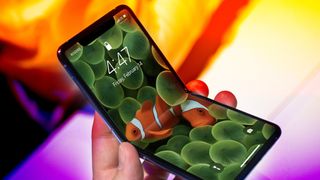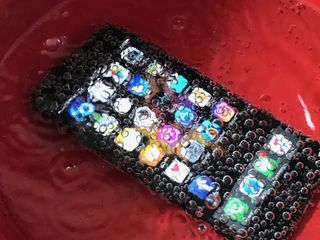6 reasons why your next phone shouldn't be a foldable

"The Samsung Galaxy Flip is the original iPhone of foldables." That's what some people have been saying and… ah… I mean, I get it. Well, first, no, it totally isn't. But I get it. I get the allure of flipping phones. I've done umpteen columns about them already.
They're new. They're fun. They're different. At least so far, because there are only a few of them out right now. In a few years, I expect there won't just be many, but generations of many, so they won't be so new or so different anymore, but they'll still be fun, and they'll still be welcomed by people who want a big screen that isn't so big in their pocket or bag.
But, I'm going to say again what I said before — no one should be buying them just yet. No one who doesn't have money to burn or is making content to earn.
No one who plans on buying and keeping one single phone for the next 3-5 years and need it to last that long and well. If that's you, you should still stay far, far away.
But the concept itself is still super intriguing to me. The iPhone of flip phones. To get to that, to be that — the iPhone Flip — what exactly would it take?
1. Novelty isn't new
This has all happened before, right? Back in the days of feature phones or dumb phones or whatever you want to call them, both candy bar and flip phones were super common. There was nothing new or novel about either, you just weighed the trade-offs and got the one you wanted.
Smartphones obliterated that for a while. Turning candy bars into slabs and flips into memories, at least for a while.
Master your iPhone in minutes
iMore offers spot-on advice and guidance from our team of experts, with decades of Apple device experience to lean on. Learn more with iMore!
Now, during that period, the iPhone was the paradigm shift. The moment when smartphones went from the early adopters of Treo and BlackBerry and Windows Phone to the mainstream acceptance of, yeah, iPhone.
And yeah, sure, the iPhone was still limited in so many ways, but all the ingredients were finally there. So much so, even if you didn't upgrade the next year, you still got the App Store and everything else that defined the modern smartphone for the next few years.
And the Galaxy Flip just isn't any of that. Not yet. It's more closely akin to the Treo 680 or BlackBerry Curve or whatever you want to call the refinement of the early adoption device. When the huge honking antennas went away, and we were pretty much at peak PDA pager phone.
That took years, so it's incredibly impressive Samsung got from the Fold to the Flip in just months. It's just going to take even more time for flips and foldables to move from novelty to the next big thing.
2. The exteriors are... underwhelming
Can we first agree that zero friction coatings like on the Galaxy Z Flip are just non-starters... or rather, no chargers? Recent iPhones, the inductive charging ones, are slippery enough. If they couldn't stay on the inductive pad, though, they wouldn't even charge. So, yeah, let's wait for them to fix that.
Next is the tiny display. It's just too tiny to be usable. Motorola did better in my book that Samsung with a bigger external display. Sure, it takes more power and leaves less space for battery, which is a double whammy, but the utility is just critical.
By folding a phone, you halve its surface area by doubling its thickness and protect its inside by creating a potential additional failure point at the hinge.
You also trade the convenience of it better fitting your pocket or bag with the inconvenience of having to open it every time you want to use it.
Those seconds and that wear and tear add up. So, perhaps counter-intuitively, the more you can do without having to open it, the better.
Now, I've mentioned before that Apple already has the Apple Watch interface that could work on the outside of a flip phone. Sort of a pocket watch interface, so to speak.
And that could certainly be useful for quickly glancing at the time or data like weather, appointments, sports scores, ski conditions, or any complication, really, and of course, notifications.
But Apple also has size classes, and a compact/compact iPhone interface could also be shown for quickly jumping into apps and doing a few, brief, important tasks, things that don't require a full screen or keyboard, without ever having to unflip the phone.
You know, like, mini-games.
3. Water-resistance-resistance

About the only other thing that will need to be addressed, eventually, is particle and liquid ingress. See, these current experimental flip phones don't have anything like the dust and water resistance we've come to expect over the last few years of phones.
But only the last few years. Flashback to even the early days of LTE phones and being able to use them in the rain or at the beach was just a beautiful dream.
An impressive IP rating will have to happen to make flip phones truly, fully mainstream again, but I think it's fair to say it'll remain one of the major trade-offs for a while still, and one of the last things that'll happen.
4. Scratchy screens
There's this story about Steve Jobs having his original iPhone prototype in his pocket, taking it out, seeing how his keys had scratched the then-plastic screen, and demanding his hardware team switch it to glass with almost no time left before it had to ship. And… they did. They went to Corning, and now we all have some form of Gorilla Glass on our phones, whether it's branded that way or not.
There's no equivalent story for modern flip phones, of course. The Galaxy Fold and Moto Razr shipped with plastic screens and the Galaxy Flip with a hair-thin glass screen overplayed with plastic.
But I'd argue scratching isn't the most important issue there. First, chemically hardened, ion-exchange glass still scratches. It still scuffs. It still breaks. Material engineering is all about trade-offs, and physics, as always, can be super hostile. Second, folding phones fold, so in some of the situations where even gorilla glass screens are the most vulnerable to scratches, like in pockets or bags, they're all closed up and protected. Honestly, it's the outside glass that we're still going to have to worry about as well.
Still, the holy grail remains making a foldable screen that's experientially as good as a slab screen. And that means it isn't just hard but feels hard under your fingers. And smooth. No lumps, no bumps.
One that doesn't rise up, detach, delaminate, or anything else that makes it feel like someone shipped you a model kit rather than a production unit.
And without an appreciable crease or break or separation, so it really is a foldable and not just the more pragmatic but less elegant hingeable.
As far as we've come from the Galaxy Fold to the Galaxy Flip, we still have exponentially farther to go before we get to even the original iPhone moment there.
5. Specs that won't last

The next thing is specs. Now, I've been saying for years that companies that bring specs to an experience fight will lose every time and that specs have become a semi-toxic crutch in tech review circles.
And, sure, some markets are more big-number-on-package driven than others. But, overall, it's not the components that matter, it's the performance.
Critically, though, it's not just today's performance that matters, it's next years and the year after that, and maybe a couple more after that.
Again, people in the tech industry change phones every year, if not month, if not week. We live very much in the now. I'm using an iPhone 11 Pro. My family, though, are using the iPhone 8. And iPhone 7. And iPhone 6s. Because the vast, vast majority of people don't, can't buy new phones every year. They buy one every 2 to 3 years. Maybe even 4 to 5 years.
And that means, for modern flip phones to become truly mainstream phones, they have to be built to last 3 to 5 years.
For most people, the most important things are battery life, cameras, and overall performance. That means the flip phone they buy today has to have battery life, camera quality, and processor overhead enough to get them through the next several years.
To get them through the day, to take photos of their kids, and to launch and run not just Android 10 and iOS 13 apps, but Android 14 and iOS 18 apps one day.
And that brings us to price.
6. The cost outweighs the value
Currently, it costs you about one and a half times as much to get a flip phone that's about three quarters as good but may only last you one quarter as long.
There's a lot of unknowns there, of course, which is why I'm really hoping we see 3 months later, 6 months later, 1 year later, and more reviews for all the early foldable phones.
But, basically, we're being charged a premium to get a phone that folds. And that's fine. I mean, I wish the companies were more up-front and put big "experimental" branding on this stuff. Hell, given the current market, that might even help them sell more. But, either way, it's a huge premium.
And, unlike an iPhone 11 Pro Max or a Galaxy S20 Ultra, you're not getting more for paying more. You're getting novel.
You can make, and some are trying to make, a fashion argument. You can absolutely make a "they are just so fun" argument. But the first time is certainly going to be way more fun than the thousandths no matter how you flip it.
So, right now, today, you're literally paying more for a phone that does slightly less and will probably last you nowhere nearly as long as the version that doesn't flip.
Some of that will be offset by clever utility. Like using the fold as a stand and making it as useful as possible while closed for when you don't need it open.
Some of that will also be offset by reduced costs as the technology matures and, you guessed it, that's when it becomes mainstream as well.
And you know we'll have reached that point when we can go into a store and choose between a candy bar slab or a flip fold, both with the same tradeoffs now that they had back then, that a MacBook Pro has today over an iMac… if you could also carry an iMac in a way that wasn't so ridiculous.
Because, at the end of the day, it's never about cost. It's always about value.
More navigation links:

- A history of the folding phone
- Galaxy Z Flip vs. Moto RAZR
- Why your next phone should be a foldable
- Why your next phone shouldn't be a foldable
- More reasons why you should hold off on a foldable
- Our phones are our most important fashion accessory
- The clamshell foldable is the new 'small' phone
- Foldables aren't the 'small' phone you want (yet)
- All the differences between foldable devices
- MrMobile explains foldables
- Should you buy a foldable phone in 2020?
- Are foldable phones the next big thing?
- Folding phones are saving us from several years of boring slabs
- Samsung is leading the charge with foldable phones
- Microsoft's approach to foldables with the Surface Duo is better

Rene Ritchie is one of the most respected Apple analysts in the business, reaching a combined audience of over 40 million readers a month. His YouTube channel, Vector, has over 90 thousand subscribers and 14 million views and his podcasts, including Debug, have been downloaded over 20 million times. He also regularly co-hosts MacBreak Weekly for the TWiT network and co-hosted CES Live! and Talk Mobile. Based in Montreal, Rene is a former director of product marketing, web developer, and graphic designer. He's authored several books and appeared on numerous television and radio segments to discuss Apple and the technology industry. When not working, he likes to cook, grapple, and spend time with his friends and family.
Most Popular





